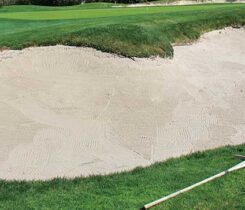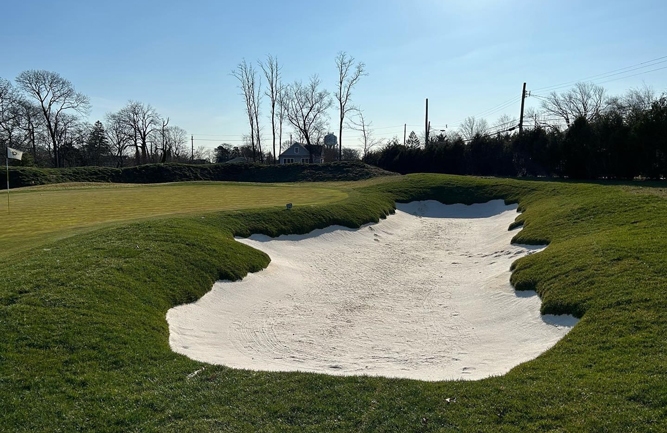Carpets on the walls
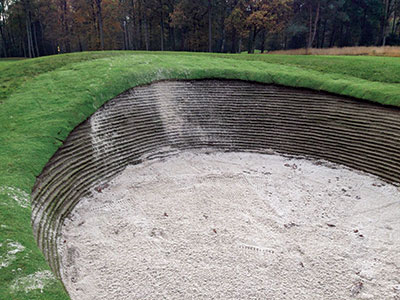
The use of stacked artificial sod on bunker walls is relatively new but can be found on golf courses in North America, Europe, Asia and Australia. This bunker is from a project at the Royal Antwerp Golf Club in Belgium.
When natural sod bunker walls become too unpredictable and expensive, a pair of superintendents turn to an artificial answer for stability.
When past hurricanes barreled through Beaufort, S.C., Superintendent Mark Mitchell’s list of repairs would include rebuilding the collapsed sod walls of Secession Golf Club’s 55 revetted bunkers. However, Mitchell’s club, just 15 miles from the Atlantic and right on a river that feeds into the ocean, didn’t need to rebuild sod walls after Hurricane Matthew hit last October.
“A lot of the bunkers were already full of water from the 20 inches of rain here,” Mitchell recalls, “but we also had a storm surge. That river came up into the golf course and the wind was beating on them, and there was wave action from the ocean. They were all full of water for two days. But when the drainage went down, the walls never moved.”
If it sounds unnatural for a bunker wall to survive such a beating, it’s because it is unnatural. The different outcome after Hurricane Matthew occurred because the course had installed a new system that uses stacked artificial turf to build bunker walls. The new artificial turf bunker-wall system looks natural, saves money and should last another two decades, Mitchell says.
“They would’ve been flattened if they were natural sod walls, and we would’ve been redoing all of them,” Mitchell says.
Reluctance rewarded
Mitchell admits he wrote off the idea of artificial turf on his bunker walls when he first heard about it. One of his members saw the artificial turf on about 20 bunkers while playing at Trump National Golf Club, Jupiter, Fla., and suggested the idea to Secession Director of Golf Mark Harmon, who brought the idea back to his superintendent. Mitchell now thanks that member while he counts the money he saves on his annual maintenance budget.
Before the artificial turf walls went up, Secession replaced the natural sod every three to four years. Over that time, the bunkers would erode and warp from the original design. The course was spending about $1,000 in materials each time, excluding the cost of labor, according to Mitchell.
Three companies currently sell artificial turf for use on bunker walls, and one has also found a way to help courses with traditional bunkers. After completing their research, Mitchell and Harmon decided to use the Wales, England-based Ecobunker. (The company now partners with IVI Golf to sell the PermaEdge Bunker System in the United States.)
Thinking outside the bunker
Company adds to aesthetics beyond links-style revetted bunkers
Though Durabunker got its start with links-style revetted bunkers, Director Rhydian Lewis says the company currently is working with more and more non-links courses in Europe. The product was first developed to mimic the traditional stacked sod look, but has now evolved by helping courses maintain bunker edges.
“The feedback we get,” Lewis says, “is that during growing season, to get the good crisp bunker edge by hand is time consuming. To stay on top of that, some clubs we have worked with were employing one seasonal (worker) to do just that job. Our product defines the bunker and gives it a crisp and clean edge without the maintenance.”
Other fans of artificial turf bunker walls include golf course architects, according to Lewis. He says the products put tools in architects’ hands that enable them to create shapes and bunker designs that before would leave the superintendent with a heavy maintenance burden. They can now make designs as complex as possible with the knowledge that the design is not going to change, because it’s a fixed edge.
“Courses are paying a lot of money to these architects to put something in front of them that members are going to like and that looks good,” Lewis says. “The issue is that these things just don’t last and the design doesn’t last as a result. With Durabunker, it’s never going to change height vertically. It’s stable, and therefore they are safeguarded in their design integrity, as are their clients.”
Lewis is confident that his clients’ bunkers will look better than they did before, with less maintenance, but he hopes that he can help them make their entire golf course better as well.
“One of the hidden benefits is superintendents aren’t having to take time to maintain the bunkers edges or walls.” Lewis notes. “They devote that time to other tasks on the golf course. Ultimately, we’re in the business of hazards, and superintendents shouldn’t take the amount of time that they are because they aren’t playing surfaces. If we can negate a lot of the time invested (in bunkers), it means that the playing surfaces get more attention and can improve.” —GBG
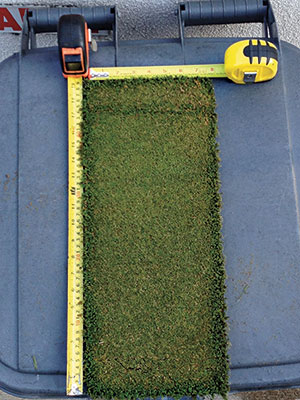
Durabunker and Ecobunker walls use second-generation artificial turf. “Over here in the UK and Europe, we are putting a lot of that down,” says Durabunkers’ Rhydian Lewis. “There’s plenty of supply.”
The team at Secession was hesitant to make a large investment in a product they weren’t completely sold on, so they arranged for Ecobunker representatives to build a pair of bunkers on the course’s practice area so members could see if they liked them.
“There were some naysayers at the beginning, and I was one of them,” Mitchell says. “A place like Secession is a links-style course that’s supposed to look old even though it’s not old, so putting some artificial turf on the course would be a big risk. Once we put it in and we saw the product for three or four months, it was unanimous that it would be stupid for us not to do it.”
Material costs for a traditional bunker redo were about $3,000 per bunker in the summer of 2015 when Secession did a complete renovation of all 55 bunkers. The initial investment to renovate the bunkers with artificial turf was three times as much, but that was fine with Mitchell because the artificial walls should last at least 25 years, or eight times longer than some of his former natural sod bunker walls.
“It pays for itself in eight years or so at our course,” Mitchell says. “Even though we rebuilt the old ones every three to four years, after two years they would start to look different. These never change.”
After Ecobunker was hired, Construction Manager Llewellyn Matthews traveled to Secession and taught six crew members how to stack and assemble the bunker walls. The crew got the hang of it after two days, but each bunker still required supervision from someone who knows golf and what the end result should look like. It took about four months for the in-house labor force to complete the 55 bunkers, working five to six days a week.
Smokey Mountain stacks
During the time that Secession had test bunkers on its practice area, Superintendent Andrew McClintock of Tennessee National Golf Club, Loudon, Tenn., was in search of a style change that would save time, money and effort with his bunkers. If a remedy couldn’t be found, his club was looking at changing 64 sod-stacked bunkers.
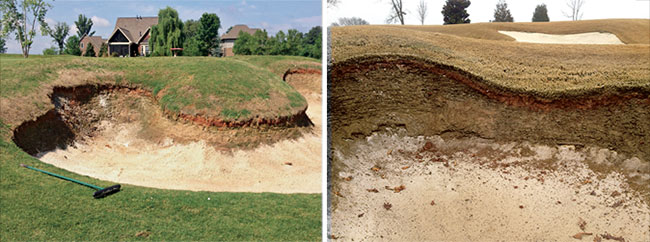
Prior to the installation of stacked artificial turf on Tennessee National’s bunker walls, Superintendent Andrew McClintock would have to rebuild the natural sod bunker walls every six to 10 years. When a new owner purchased the course, he suggested that they should fill in all 64 of the bunkers because “he didn’t want to spend money on something that wouldn’t last,” according to McClintock.
“Our bunkers were built the traditional way, with sod that we would rebuild six to 10 a year at $5,000 apiece, and then we had a new owner,” says McClintock. “The new owner said he didn’t want to put money into something that wouldn’t last. He suggested that we fill them in, and we didn’t want to do that. We searched around online and came up with the stacked artificial turf solution Durabunker.”
Durabunker is the other company in the artificial turf bunker-wall business, but two of them have a shared history. In 2010, Durabunker’s Company Director Rhydian Lewis formed the company Envirosports Ltd. with Ecobunker’s CEO Richard Allen. While working under the name Envirosports, the company brought an artificial sod wall product to market called Envirobunker. In 2014, Lewis and Allen decided to go their separate ways and each formed their own companies.
Before Tennessee National purchased materials from Durabunker, McClintock and a team from the club flew down to Trump National to talk to its superintendent and to see the bunkers. Soon after that trip, the group visited Secession and Mitchell to see Ecobunker’s practice-area bunkers in action. As soon as they got back to Tennessee, the club pulled the trigger on renovating its bunkers.
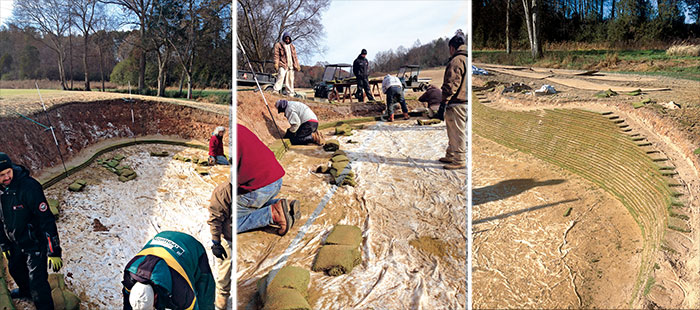
McClintock and his team were against filling in the bunkers, so they scoured the Internet for an alternative option. They ended up finding Durabunker, and Tennessee National was the second course in the United States to purchase the product from the company. The club paid about $5,000 per bunker, but the budget allowed for only 32 bunkers to remain, with the other 32 filled in.
The labor was contracted to an outside company, and in November 2014, Lewis made a week-long trip to Tennessee National to oversee the beginning of the construction. The project was completed at the end of February 2015. The club paid about $5,000 per bunker to lay the stacked artificial turf and add Better Billy Bunker bunker liners. The budget allowed for only 32 bunkers to remain, with the other 32 filled in. The remaining 32 require little maintenance, according to McClintock.
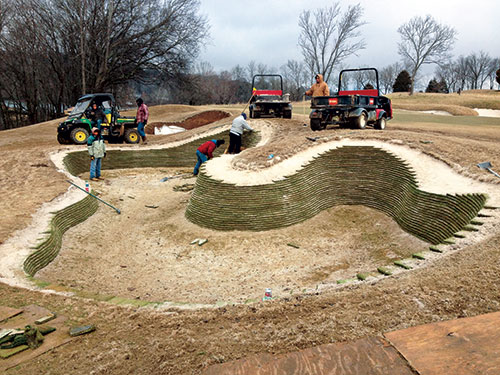
According to McClintock, all of the artificial turf came from a European distributor across the Atlantic Ocean in eight shipping containers, and the entire installation process took almost four months. McClintock adds that his membership loves the new walls.
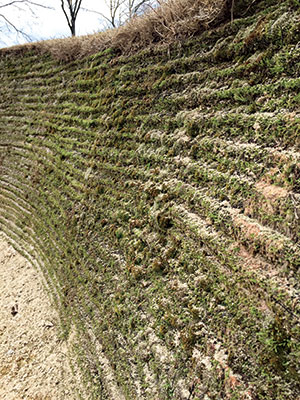 “It used to be it would rain 3 inches and you’d come in with multiple bunkers collapsed or washed out,” he notes. “Since we put them in I haven’t touched them, except moving some sand here or there and occasionally throw some Roundup on whatever is growing through the wall. But we leave the moss, algae and whatever is growing on it. They look better now than the day that they put them in, and the members love them.”
“It used to be it would rain 3 inches and you’d come in with multiple bunkers collapsed or washed out,” he notes. “Since we put them in I haven’t touched them, except moving some sand here or there and occasionally throw some Roundup on whatever is growing through the wall. But we leave the moss, algae and whatever is growing on it. They look better now than the day that they put them in, and the members love them.”
Both McClintock and Mitchell agree that because the bunker walls are artificial the aesthetics are better today than when they were installed.
“They don’t change with weather, rain, wind or play,” Mitchell adds. “Players can’t take chunks out of them with the club or a ball. They look a little bit better because they start to get some age on them. They have some algae growing in them and look more natural.”
It’d be hard to say who approves of the bunkers more at Secession — its superintendent or its members. Mitchell says that before the renovation, the club’s bunkers were an eyesore and always an afterthought. Now, however, they are probably Secession’s most talked about feature, and visitors to the course are not always convinced that the walls are made of artificial turf.
“We’ve had multiple times where members and their guests will come and they have to be told that they’re fake,” Mitchell says. “They basically have to be right up on them or almost touch them.”
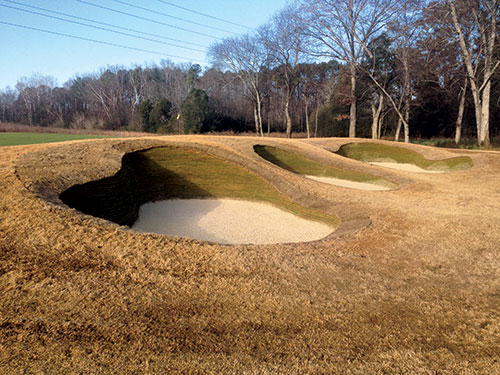
“Since we put them in I haven’t touched them, except moving some sand here or there…,” says McClintock. “They look better now than the day that they put them in, and the members love them.”
Photos: top: Durabunker; all others: Andrew McClintock
Editor’s note — a previous version of this story stated that Durabunker’s “Company Director Rhydian Lewis worked with Ecobunker before splitting off to start his own company in May 2014.” The error in fact has been revised and the correct company history is in this version.









